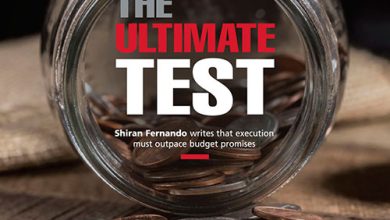EXTERNAL TRADE
IMPLICATIONS OF US TRADE TARIFFS
Shiran Fernando analyses the impact of US tariffs on Sri Lanka
Sri Lanka has faced an unrelenting series of economic shocks over the past few years. The internal disruptions began with the constitutional crisis in 2018, followed by the devastating Easter Sunday attacks in 2019. And the COVID-19 pandemic delivered another severe blow, which resulted in a sovereign debt crisis fuelled by both external pressure and domestic policy missteps.
The years 2023 and 2024 marked a period of hard-fought stabilisation and recovery, which was positioning Sri Lanka for a potential economic take off in 2025. However, the country has to now deal with the imposition of US tariffs – a serious problem because a quarter of goods exported go to the United States.
TRADE IMBALANCE President Donald Trump has long emphasised the need to address his country’s trade imbalances, which was a central theme during his first term in office.
Initially, the focus was on China. However, in the lead up to the 2024 presidential election and thereafter, he signalled plans to impose reciprocal tariffs on countries that the United States runs a trade deficit with. This move stems from America’s combined trade and services deficit that exceeds US$ 1 trillion – that’s between three and four percent of its GDP.
With a trade surplus of approximately 2.6 billion dollars with the US, Sri Lanka was marked for tariffs. And on 2 April, the island was assigned a 44 percent reciprocal tariff based on its trade imbalance. This calculation is relatively straightforward as the island’s trade deficit relative to its total exports to the United States yields an 88 percent ratio.
Applying 50 percent of this ratio results in the 44 percent tariff. Though termed a ‘reciprocal tax,’ it effectively functions as a proportional levy on imports entering the US, tied to the size of the trade imbalance.
MONETARY ORDER The recent tariffs are likely to be the first step in a broader US strategy to move away from the current global monetary system.
Under the existing framework, America’s trade deficit effectively finances itself through capital inflows by way of investments in US equities, debt instruments and other assets.
For instance, countries such as China – which maintain substantial trade and current account surpluses – reinvest them by purchasing US treasuries. This dynamic has made instruments such as the US 10 year bond a critical benchmark for pricing financial assets globally.
In simple terms, the recycling of trade deficits back into the American financial system has been a cornerstone of the US Dollar’s role as the world’s primary reserve currency. However, Trump’s new approach signals a potential shift in this cycle with strong implications for the global financial system.
INVESTOR FEARS In the week following the tariff announcement, global markets turned extremely volatile; the dollar weakened, bond yields rose, stock markets fell and gold hit record highs as investors sought safety. Over 70 trade dependent countries including Sri Lanka wrote to the US administration, expressing concern and a willingness to address trade imbalances.
Then on 9 April, Trump announced a 90 day pause of the tariffs, although those on Chinese goods continued to rise amid escalating tensions.
Negotiations have begun with the US focussing on Japan, South Korea and Vietnam. US Treasury Secretary Scott Bessent described this as part of a “Grand Encirclement Strategy” to pressure China into a better trade deal.
SRI LANKAN ISSUE Even if tariffs on Sri Lanka are reduced to a baseline of 10 percent after the 90 day pause, the uncertainty has already shaken trade and investment sentiment. In its April update, the IMF cut global growth forecasts by 0.5 percent with the US, UK and EU seeing similar downgrades.
Higher tariffs mean rising production costs, which will likely be passed on to consumers, making goods more expensive.
The ensuing inflation combined with slowing demand is expected to weaken export volumes to Sri Lanka’s key markets. The only positive is the downward pressure on oil prices, which could ease Sri Lanka’s fuel import bill.
REFORMS PROCEED It took a debt crisis and financial rescue package from the International Monetary Fund for Sri Lanka’s first generation of reforms – including the new Central Bank of Sri Lanka Act, Public Financial Management Act, Anti-Corruption Act, Sri Lanka Electricity Act and Economic Transformation Act – to be established.
It’s crucial to now leverage the tariff shock and push through second generation reforms that are needed to sustain growth and stability.
Key priorities include phasing out para-tariffs, establishing a consistent and transparent tariff framework, addressing non-tariff barriers, and advancing trade facilitation reforms such as modernising the Customs Ordinance and implementing the National Single Window.
At the same time, this situation presents an opportunity to diversify into new export markets and broaden Sri Lanka’s product portfolio. Achieving this will not be easy but as history shows, a crisis often provides the best chance to drive lasting officiel.







